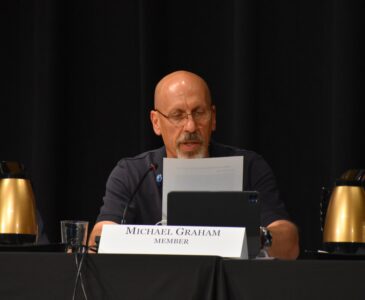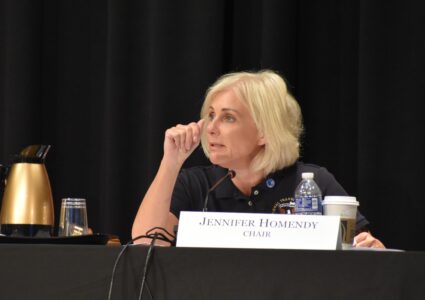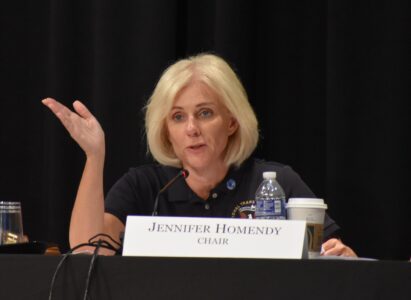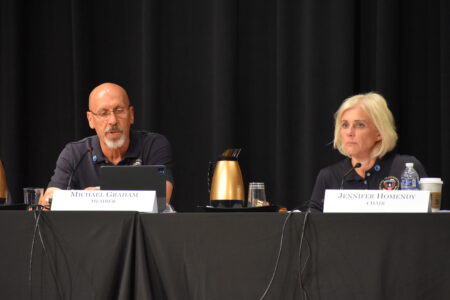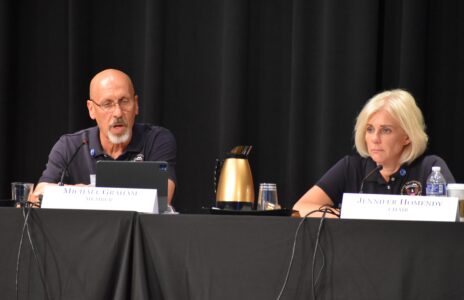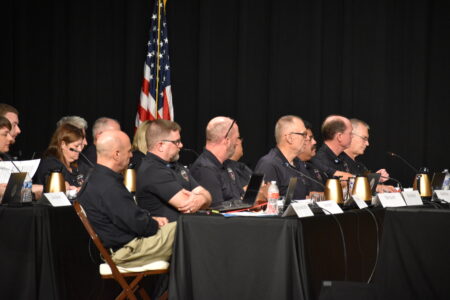NTSB draft report concludes hot wheel bearing caused derailment, vent-and-burn unnecessary
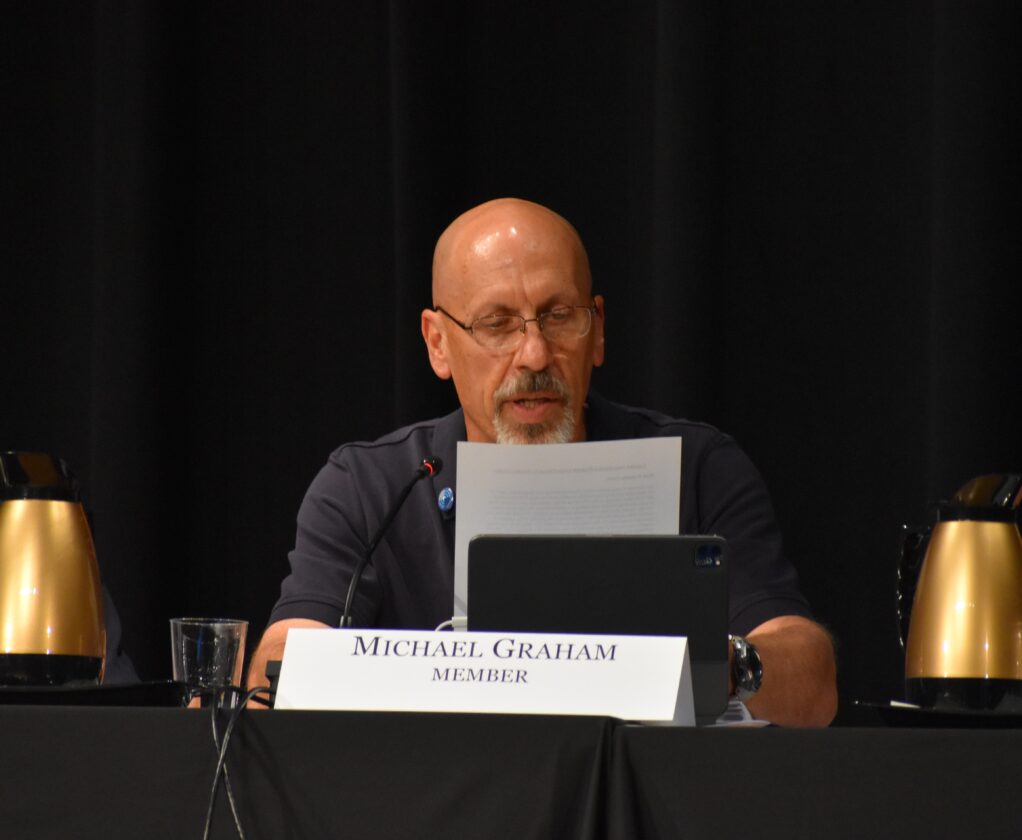
NTSB Board Member Michael Graham reads the draft of the agency’s final report into the probable cause of last year’s Norfolk Southern train derailment during a public board meeting in East Palestine on Tuesday. (Photo of Stephanie Elverd)
EAST PALESTINE — During a public board meeting held in East Palestine on Tuesday, the National Transportation Safety Board (NTSB) presented its final findings of a year-long investigation into the Norfolk Southern train derailment, made more than 30 preventative recommendations and voted on the rail disaster’s probable cause, confirming that a failed wheel bearing — missed by wayside detectors in Salem after the train was already on fire — was the catalyst of the fiery 38-car pile-up.
“The National Transportation Safety Board determines the probable cause of the derailment involving Norfolk Southern Railway Train 32N was the failure of the L1 bearing on the 23rd railcar on the consist that overheated and caused the axle to separate, derailing the train and leading to a post-derailment fire which likely began from a Class 3 flammable liquid from a DOT-111 tank car that was punctured in the derailment,” the agency’s approved draft report stated.
Had the crew, which the NTSB concluded followed proper procedure and protocol, been alerted of the fire, the train could have been stopped before complete wheel bearing failure.
“We know fire burns higher than 103 degrees above ambient, so, in theory, the Salem hot bearing detector should have shown a critical alarm. Instead, the detector sent a non-critical alarm to the back-office analyst,” NTSB Mechanical Investigator Joey Rhine said. “The Salem hot bearing detector did not reflect the true temperature of the bearing.”
The NTSB also took Norfolk Southern to task, calling the railroad out on its decision to vent and burn five tank cars of vinyl chloride in the days following the derailment and ignoring the advice of experts on the scene from OxyVinyls, the manufacturer and shipper of the vinyl chloride, that a chemical reaction known as polymerization was not occurring.

Chair Jennifer Homendy and the rest of the board vote on the probable cause of last year’s Norfolk Southern train derailment during a public board meeting in East Palestine on Tuesday. (Photo of Stephanie Elverd)
“Also contributing to the severity of hazardous material release were the failure of Norfolk Southern and its contractors to communicate relevant expertise and dissenting opinions to the incident commander and the inaccurate representation from Norfolk Southern and its contractors that the tank cars were at risk of claustrophobic failure from a polymerization reaction which created unwarranted urgency and led to the unnecessary decision to vent and burn five derailed vinyl chloride tank cars to prevent a polymerization-induced tank car rupture,” the NTSB report said.
The NTSB investigation determined that Norfolk Southern contractor Specialized Professional Services Inc. (SPSI) spoke to OxyVinyls at the scene and was told temperatures were decreasing and that a BLEVE was not probable. Still, SPSI pushed for the vent and burn, citing a 70-minute violent release from a pressure release valve on one tanker that OxyVinyls insisted was not a sign that the tank had grown unstable. In order for the tanks to have exploded, polymerization was needed, and polymerization requires both rapidly increasing temperatures and an infusion of oxygen. The NTSB said there was evidence of either and that the pressure release valves on the tankers were functioning as they should. Norfolk Southern had that information but it never made its way to Ohio Gov. Mike DeWine, Pennsylvania Gov. Josh Shapiro and East Palestine Fire Chief Keith Drabick, who as the incident commander made the final decision to release and burn the chemicals.
“Norfolk Southern and its contractors continued to assert the necessity of a vent and burn, even though available evidence should have led them to re-evaluate their initial conclusion,” NTSB Investigator Paul Stancil said. “Available scientific information and evidence suggests that the vinyl chloride did not undergo polymerization therefore a vent-and-burn would not have been necessary to prevent a polymerization-induced tank car rupture.”
The draft report also criticized Norfolk Southern for failing to get the train’s consist (a detailed list of the train’s car and what each is carrying) into the hands of emergency responders in the hours following the derailment, and concluded that more training is paramount for Ohio volunteer firefighters as those who responded to the derailment lacked knowledge needed to combat a fire of that magnitude.
“Contributing to the exposure of emergency responders and the public to post enrollment hazards was Norfolk Southern Railway’s delay in transmitting the train’s consist information to emergency responders and the State of Ohio’s insufficient training for volunteer firefighters,” the report said.
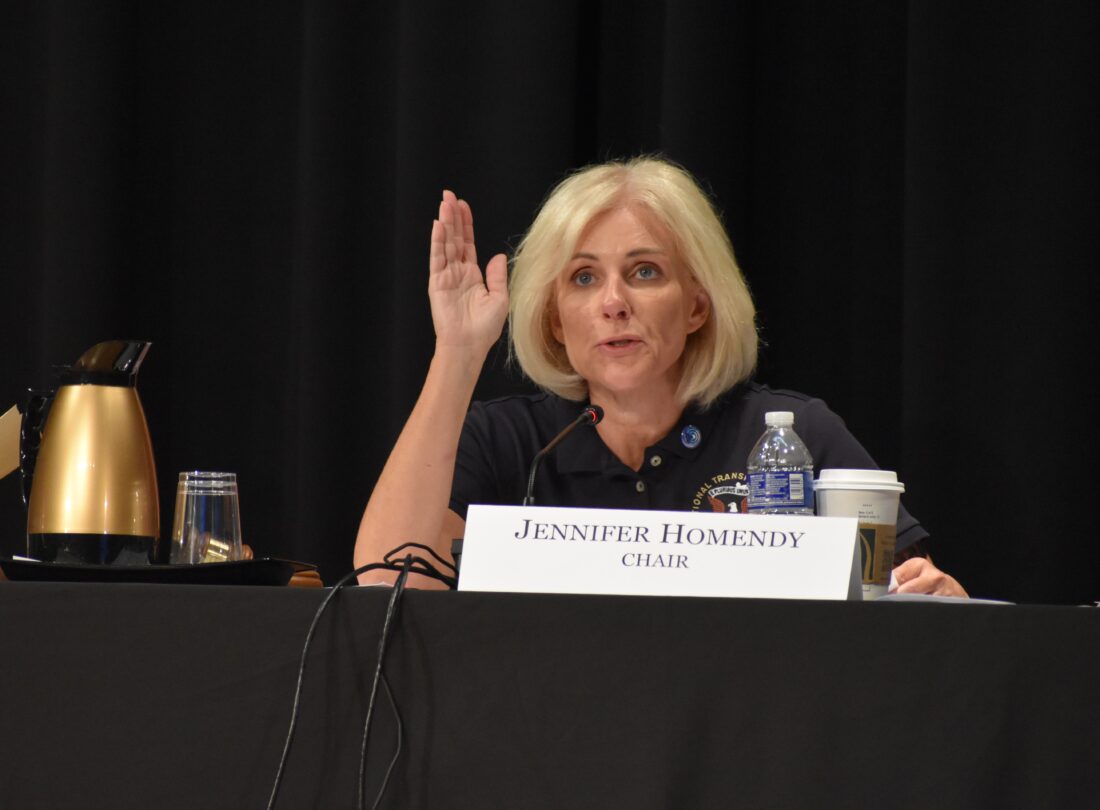
The NTSB said East Palestine dispatch made repeated calls to Norfolk Southern’s headquarters minutes after the derailment. The consist was requested from Norfolk Southern at 9:04 p.m. That call was not returned. Dispatch called again at 9:30 to determine if an evacuation of the town was warranted. No information was obtained from that call either. The consist finally reached the Columbiana County Emergency Management Agency via email from Norfolk Southern at 9:56 p.m, nearly an hour after the train had derailed. It was 10 p.m. before rabick received a copy of the consist. The East Palestine Police Department was finally given the consist at 1:30 a.m.
Meanwhile, first responders — not knowing what was on the train as most of the placards had been destroyed in the fire — should have evacuated a 1-mile radius immediately under American Response Guide 111 “unidentified cargo” procedures.
The NTSB report also scrutinized continuous use of DOT-111’s “in hazardous material service” as nearly all of the tank cars damaged in the derailment were 111’s and their spilled contents “contributed to the severity of the post-derailment fire.”
Most of the NTSB recommendations centered around the decision to vent-and-burn the tankers of vinyl chloride. The NTSB recommended procedures and guidelines be set to follow in the future when making such a decision. The agency also recommended that the shippers and manufacturers of hazardous material being direct communication with command staff at future disasters and that Norfolk Southern revise an incident report with Pipeline and Hazardous Materials Safety Administration (PHMSA) “to accurately reflect the package failure cause for the five vinyl chloride tank cars” and acknowledge that polymerization was not occurring.” Other recommendations included a quick phase out of the DOT-111 fleet for hazardous transport, real-time delivery of an accurate train consist to first responders at derailments, placards that can withstand derailments and subsequent fires and more specialized training for Ohio volunteer firefighters.
The NTSB also made a recommendation to the Columbiana County Emergency Management Agency, asking the county EMA to implement a policy that ensures that, in the event of a derailment, information received by the agency — specifically the train’s consist — is immediately delivered to members of those in command at the scene.
- NTSB Board Member Michael Graham reads the draft of the agency’s final report into the probable cause of last year’s Norfolk Southern train derailment during a public board meeting in East Palestine on Tuesday. (Photo of Stephanie Elverd)
- Chair Jennifer Homendy and the rest of the board vote on the probable cause of last year’s Norfolk Southern train derailment during a public board meeting in East Palestine on Tuesday. (Photo of Stephanie Elverd)
- Chair Jennifer Homendy and the rest of the board vote on the probable cause of last year’s Norfolk Southern train derailment during a public board meeting in East Palestine on Tuesday. (Photo of Stephanie Elverd)
- Chair Jennifer Homendy (right) listens as Board Member Michael Graham reads the draft of the agency’s final report into the probable cause of last year’s Norfolk Southern train derailment during a public board meeting in East Palestine on Tuesday. (Photo of Stephanie Elverd)
- Chair Jennifer Homendy (right) listens as Board Member Michael Graham reads the draft of the agency’s final report into the probable cause of last year’s Norfolk Southern train derailment during a public board meeting in East Palestine on Tuesday. (Photo of Stephanie Elverd)
- Members of the NTSB staff along with the board votes on the probable cause of last year’s Norfolk Southern train derailment during a public board meeting in East Palestine on Tuesday. (Photo of Stephanie Elverd)
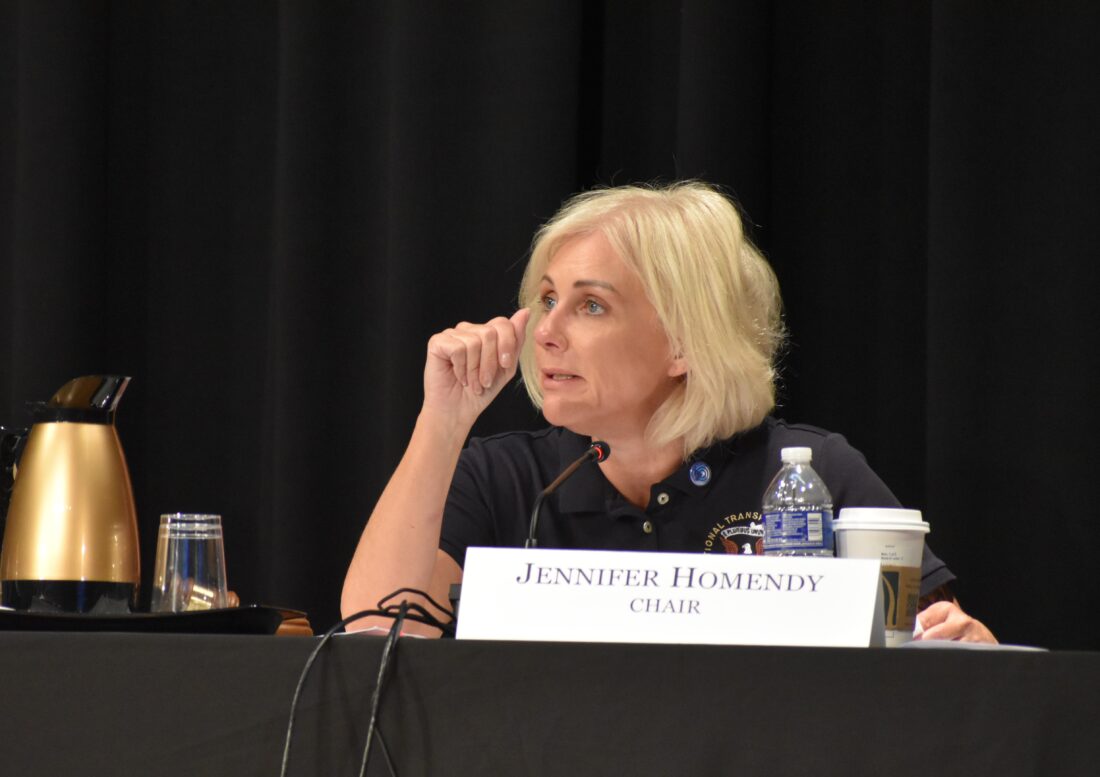
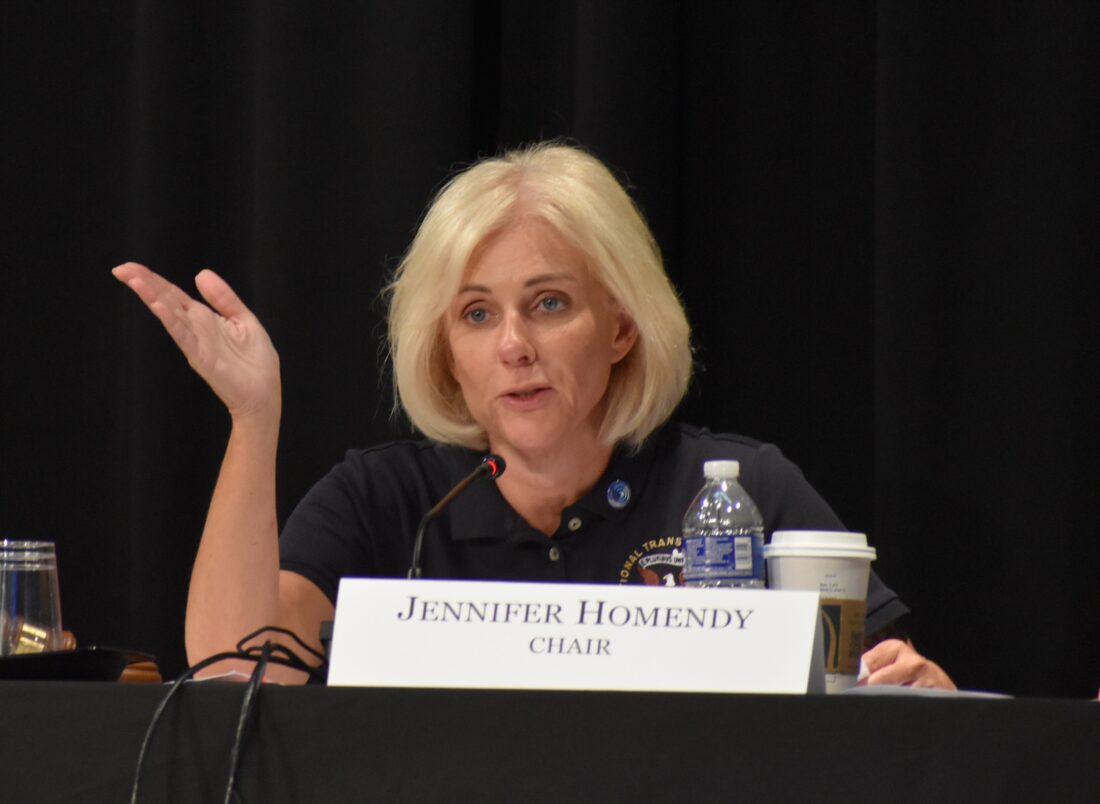
Chair Jennifer Homendy and the rest of the board vote on the probable cause of last year’s Norfolk Southern train derailment during a public board meeting in East Palestine on Tuesday. (Photo of Stephanie Elverd)
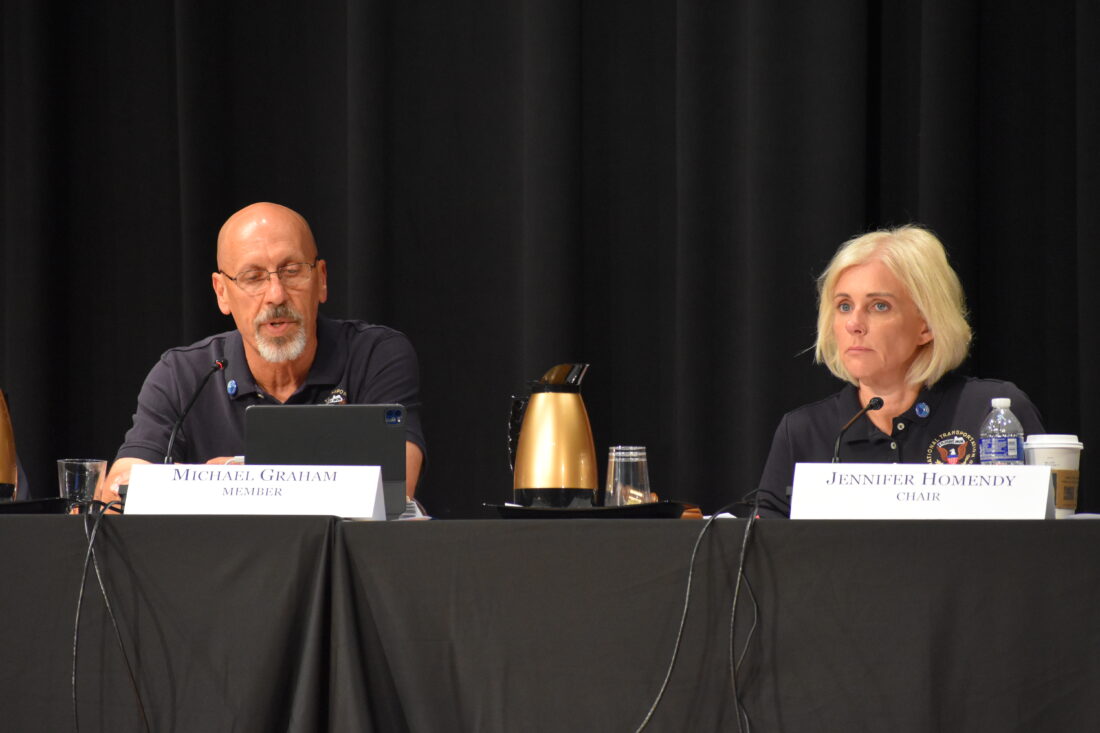
Chair Jennifer Homendy (right) listens as Board Member Michael Graham reads the draft of the agency’s final report into the probable cause of last year’s Norfolk Southern train derailment during a public board meeting in East Palestine on Tuesday. (Photo of Stephanie Elverd)
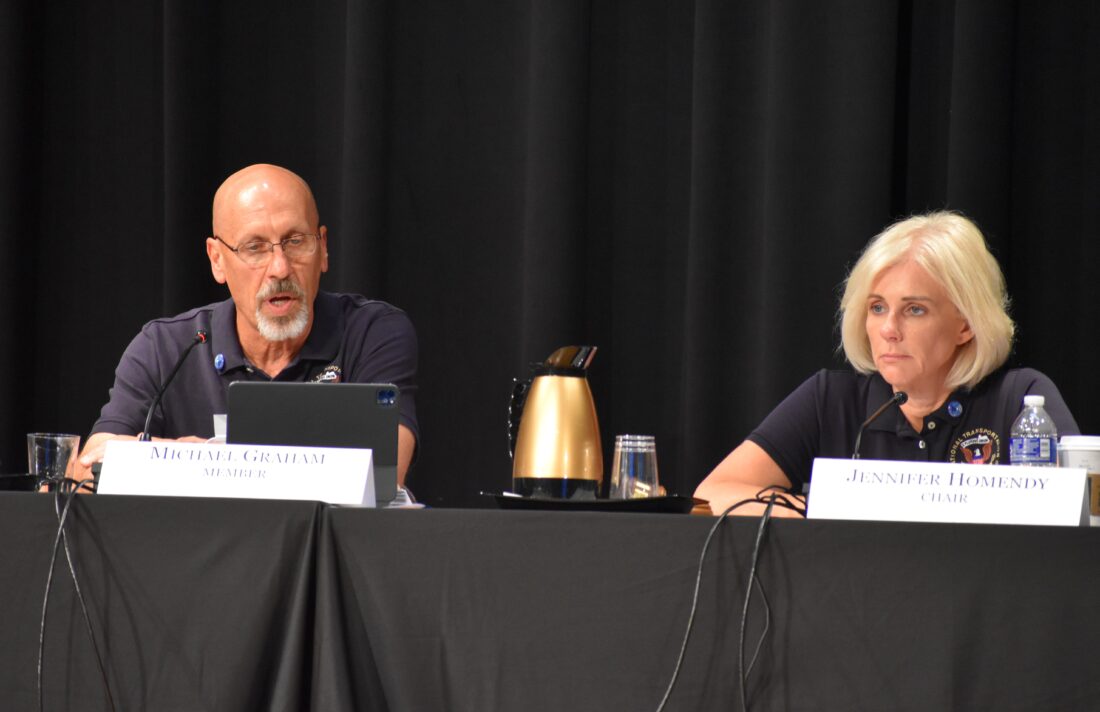
Chair Jennifer Homendy (right) listens as Board Member Michael Graham reads the draft of the agency’s final report into the probable cause of last year’s Norfolk Southern train derailment during a public board meeting in East Palestine on Tuesday. (Photo of Stephanie Elverd)
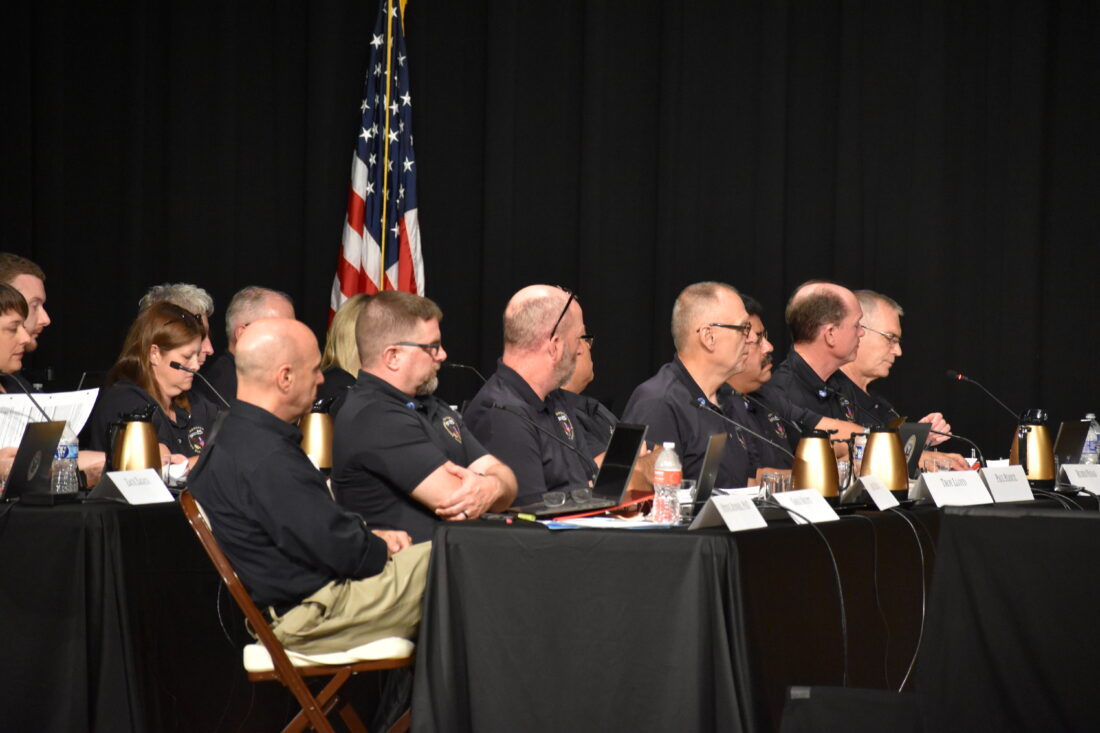
Members of the NTSB staff along with the board votes on the probable cause of last year’s Norfolk Southern train derailment during a public board meeting in East Palestine on Tuesday. (Photo of Stephanie Elverd)

